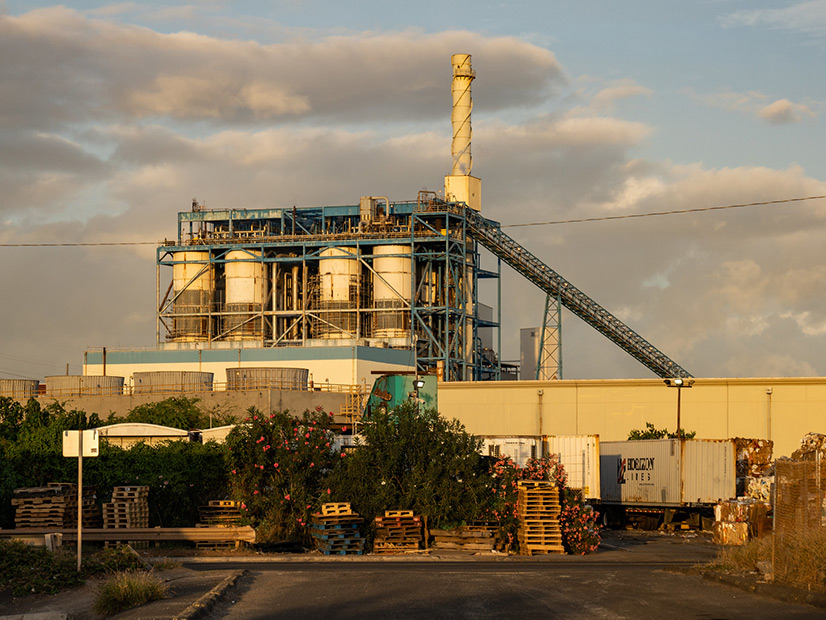
Citing “the urgency of the global effort to slow climate change,” Hawaiian Electric Company (HECO) last week said it will commit to reducing its carbon emissions to 70% below 2005 levels by 2030.
Th utility had previously committed to reducing greenhouse gas emissions by 50% by that year on a path to achieving net-zero by 2045.
HECO’s announcement came amid a flurry of declarations and pledges issued from the COP26 climate conference in Glasgow, Scotland, including from Hawaii Gov. David Ige, who is attending the conference.
“Hawaiian Electric has a critical role in reducing carbon emissions this decade in Hawaii, especially in transportation, so this new goal is significant,” Ige said in a statement Friday. “The COP26 meetings made absolutely clear that even though Hawaii has done a lot, we have to do even more.”
HECO said its 70% target will contribute heavily to Hawaii’s effort to reduce its economy-wide greenhouse gas emissions by 50% by 2030.
“The runway is getting shorter all the time,” HECO CEO Scott Seu said. “The 2030 goal is a stretch for us, but we have to commit to bold actions in the next few years if we’re to have any hope of stalling climate change. We want to look back at this time and know we did all we could do to stop things from getting worse.”
HECO’s 2030 plan calls for installing 50,000 new rooftop solar systems, adding 1 GW of renewable energy projects, and retiring “at least” six fossil-fuel generating units and reducing the use of others.
The utility also commits to using more grid-scale and customer-owned energy storage, expanding geothermal resources, and creating programs that “provide customers incentives for using clean, lower-cost energy at certain times of the day and using less fossil-fueled energy at night.”
“By 2030, Hawaiian Electric’s renewable portfolio standard is expected to exceed 70%, with renewable resources available to provide close to 100% of the electricity generated on Hawaii Island and in Maui County,” the utility said.
New Life for AES Hawaii Plant?
HECO’s announcement highlights the utility’s plan to close Hawaii’s last coal-fired generator in September 2022, but it makes no mention of potential future uses for the 180-MW AES Hawaii power plant, currently the largest single source of capacity on Oahu.
A recent series of docketed exchanges among the Hawaii Public Utilities Commission, state senators, AES and the Hawaii Natural Energy Institute (HNEI) signal renewed interest in converting the plant to burn biomass, an idea that HECO previously rejected.
The PUC docket (2021-0024) contains a summary of a recent HNEI study that found that re-powering AES Hawaii with biomass could result in a 20% increase in renewable use, allowing HECO to reach its 2040 renewable portfolio standard goals a decade early.
HNEI additionally found that the converted plant could cost-effectively displace use of oil-fired generators and possibly allow for early retirement of those units. The conversion would also result in a capacity increase “equal to 500 MW of photovoltaic (PV) plus battery-energy storage solutions,” the equivalent of 4,000 to 5,000 acres of land or 180,000 home solar PV rooftop installations.
However, the biomass conversion would not limit future development of solar resources, the study found.
But HNEI acknowledged that its study did not evaluate the sustainability of the biomass resource or conduct a detailed cost assessment, both of which were considered out-of-scope.
Following on that study, the docket also contains an Oct. 18 letter to AES in which Democratic senators Donovan Dela Cruz and Glenn Wakai restate HNEI’s findings on the benefits of a biomass conversion and urge the company “to be actively engaged in this evaluation process with the state and [HECO] to determine if the conversion would be feasible for AES and for the state.”
In its Oct. 28 reply to the senators, AES noted that HECO had rebuffed a 2018 proposal to convert the plant to biomass because the utility “felt that the proposal was not competitive versus their forecasted capacity additions and associated oil price forecast.”
“Based on the expressed lack of interest by both Hawaiian Electric and the Hawaii Public Utilities Commission, we are currently planning for decommissioning … However, there is still time to determine if such a conversion is best for the State of Hawaii prior to decommissioning,” AES wrote.
On Nov. 3, the PUC issued a letter to HECO and AES providing guidance for the companies if they choose to negotiate a new power purchase agreement (PPA) for a converted AES Hawaii plant.
“In doing so, the commission is not expressing any opinion on whether such an agreement should be filed, but rather provides this letter simply for informational purposes in the event an agreement is later filed,” the PUC wrote.
In the event of a new PPA, the PUC will seek clarity on the source of biomass feedstock for the plant, a “comprehensive review” of grid reliability impacts and a quantification of total bill impacts for ratepayers, among other items.

